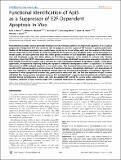| dc.contributor.author | Morris, Erick J | |
| dc.contributor.author | Michaud, William A | |
| dc.contributor.author | Ji, Jun-Yuan | |
| dc.contributor.author | Moon, Nam-Sung | |
| dc.contributor.author | Rocco, James W | |
| dc.contributor.author | Dyson, Nicholas John | |
| dc.date.accessioned | 2011-02-18T17:10:51Z | |
| dc.date.issued | 2006 | |
| dc.identifier.citation | Morris, Erick J., William A. Michaud, Jun-Yuan Ji, Nam-Sung Moon, James W. Rocco, and Nicholas J. Dyson. 2006. Functional Identification of Api5 as a Suppressor of E2F-Dependent Apoptosis In Vivo. PLoS Genetics 2(11): e196. | en_US |
| dc.identifier.issn | 1553-7390 | en_US |
| dc.identifier.uri | http://nrs.harvard.edu/urn-3:HUL.InstRepos:4727704 | |
| dc.description.abstract | Retinoblastoma protein and E2-promoter binding factor (E2F) family members are important regulators of G1-S phase progression. Deregulated E2F also sensitizes cells to apoptosis, but this aspect of E2F function is poorly understood. Studies of E2F-induced apoptosis have mostly been carried out in tissue culture cells, and the analysis of the factors that are important for this process has been restricted to the testing of a few candidate genes. Using Drosophila as a model system, we have generated tools that allow genetic modifiers of E2F-dependent apoptosis to be identified in vivo and developed assays that allow effects on E2F-induced apoptosis to be studied in cultured cells. Genetic interactions show that dE2F1-dependent apoptosis in vivo involves dArk/Apaf1 apoptosome-dependent activation of both initiator and effector caspases and is sensitive to levels of Drosophila inhibitor of apoptosis-1 (dIAP1). Using these approaches, we report the surprising finding that apoptosis inhibitor-5/antiapoptosis clone-11 (Api5/Aac11) is a critical determinant of dE2F1-induced apoptosis in vivo and in vitro. This functional interaction occurs in multiple tissues, is specific to E2F-induced apoptosis, and is conserved from flies to humans. Interestingly, Api5/Aac11 acts downstream of E2F and suppresses E2F-dependent apoptosis without generally blocking E2F-dependent transcription. Api5/Aac11 expression is often upregulated in tumor cells, particularly in metastatic cells. We find that depletion of Api5 is tumor cell lethal. The strong genetic interaction between E2F and Api5/Aac11 suggests that elevated levels of Api5 may be selected during tumorigenesis to allow cells with deregulated E2F activity to survive under suboptimal conditions. Therefore, inhibition of Api5 function might offer a possible mechanism for antitumor exploitation. | en_US |
| dc.language.iso | en_US | en_US |
| dc.publisher | Public Library of Science | en_US |
| dc.relation.isversionof | doi:10.1371/journal.pgen.0020196 | en_US |
| dc.relation.hasversion | http://www.ncbi.nlm.nih.gov/pmc/articles/PMC1636698/pdf/ | en_US |
| dash.license | LAA | |
| dc.subject | cancer biology | en_US |
| dc.subject | cell biology | en_US |
| dc.subject | pathology | en_US |
| dc.subject | genetics | en_US |
| dc.subject | gene expression | en_US |
| dc.subject | genetics of disease | en_US |
| dc.subject | cancer | en_US |
| dc.subject | Drosophila | en_US |
| dc.subject | homo (human) | en_US |
| dc.subject | in vitro | en_US |
| dc.title | Functional Identification of Api5 as a Suppressor of E2F-Dependent Apoptosis In Vivo | en_US |
| dc.type | Journal Article | en_US |
| dc.description.version | Version of Record | en_US |
| dc.relation.journal | PLoS Genetics | en_US |
| dash.depositing.author | Dyson, Nicholas John | |
| dc.date.available | 2011-02-18T17:10:51Z | |
| dash.affiliation.other | HMS^Medicine-Massachusetts General Hospital | en_US |
| dc.identifier.doi | 10.1371/journal.pgen.0020196 | * |
| dash.contributor.affiliated | Rocco, James W | |
| dash.contributor.affiliated | Dyson, Nicholas | |


